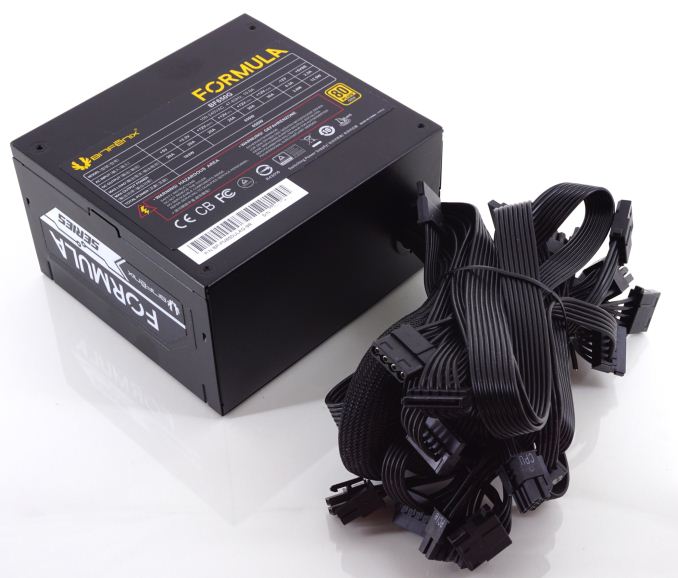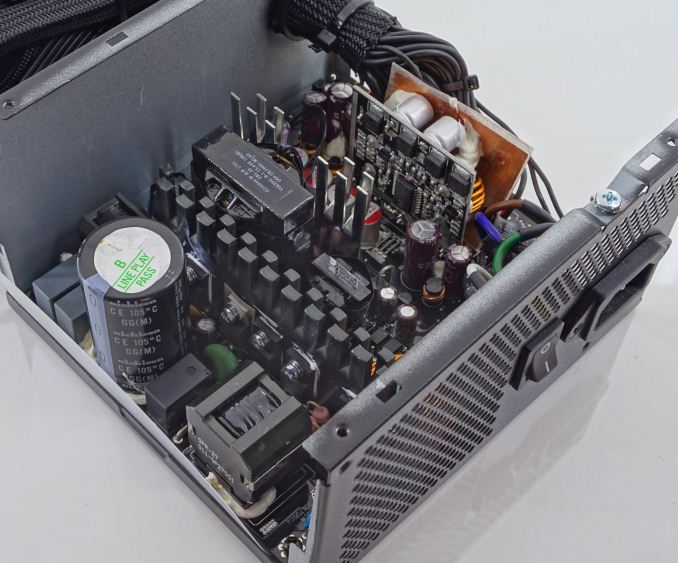The BitFenix Formula Gold 650W PSU Review: Balanced
by E. Fylladitakis on June 13, 2018 8:00 AM EST- Posted in
- Cases/Cooling/PSUs
- PSUs
- 80Plus Gold
- bitfenix
- 650W
Conclusion
It is obvious that BitFenix has positioned the Formula Gold series as a cost-effective power supply for users who are after high reliability and performance but are not particularly concerned about the aesthetics of their system. The Formula Gold is the fruit of their continuous cooperation with Channel Well Technology (CWT), an OEM known for their excellent mid-range designs. To that end the 650-Watt version that we reviewed today offers ample power for any gaming system with a single graphics card, exactly the market BitFenix is going after.
In terms of performance, the Formula Gold may not be breaking any records but it does offer above-average overall performance. Electrical performance is its strong suit, with excellent voltage regulation and great filtering. It also is capable of honoring its 80Plus Gold certification regardless of the input voltage. The Formula Gold also offers very good acoustics performance under normal operating conditions, with the unit's fan staying almost entirely silent most of the time. Only thermal performance is mediocre, which is due to the far too simplistic heatsinks, but it will not become an issue unless the Formula Gold is operating in a very hot environment and under a continuous heavy load.
Aesthetics were partially sacrificed to reduce the retail price of the product. The biggest omission is the lack of even partial modularity, as all of the cables are hardwired inside the PSU. The exclusion of an entire secondary PCB and the several connectors that a modular design would need have significantly reduces the PSU's manufacturing cost, as both the bill of materials and the process time is reduced. Nevertheless, BitFenix did not forgo aesthetics entirely, with the designer applying simple but significant touches, such as the unique rectangular fan opening and the all-black design.
The Formula Gold is made with very high-quality parts and, true to their word, BitFenix is sourcing all capacitors from Japanese manufacturers. Our only complaint lies with the relatively small heatsinks that, as we have seen in the previous pages of this review, can definitely impact the thermal performance of the unit. Slightly better heatsinks would have increased this unit's thermal performance significantly, though admittedly it would also increase its manufacturing cost.
Speaking of cost, next to its solid electrical performance, cost is the other angle BitFenix is playing with this power supply, touting that it can provide outstanding performance at an unparalleled price tag. However a quick market search finds that there are several similar 80Plus Gold units that can rival the price tag of the Formula Gold. Some are even of modular design and are selling for roughly the same price or even less. This, along with the limited availability of the PSU, will certainly be a bit of a headache for BitFenix. The Formula Gold certainly is a worthy product that will leave no mainstream user disappointed but, in terms of value, it currently does not really stand out of the crowd.












12 Comments
View All Comments
DanNeely - Wednesday, June 13, 2018 - link
"Modern power supplies work on both systems, however the nature of switching means that they are slightly more efficient with higher voltage inputs. "Is there something specific to switch mode design that makes lower voltage hurt? I'd always assumed it the difference was due to the 4x higher I^2*R resistive losses on the input end.
E.Fyll - Thursday, June 14, 2018 - link
That is generally correct. Actually, a lower input voltage will decrease the switching-related frequency losses as well (the switching cycle is longer to maintain the same energy output). That's why this PSU displayed almost identical efficiency at lower loads regardless of the input voltage -the resistive losses are higher with a 115V input but the switching losses at low loads are lower, so they virtually negate each other. At higher loads however, the switching losses are minimized regardless of the input voltage, whereas the resistive losses are (theoretically) always four times higher. They actually tend to be even higher than that, because higher component temperatures increase the resistive losses, and the higher resistive losses increase the component temperatures even further. It's a vicious circle.benedict - Wednesday, June 13, 2018 - link
Sell it for 60-65$ and it will be a hit. At 80$ it's just one of many.Orange14 - Wednesday, June 13, 2018 - link
For $10 more I could purchase an equivalent wattage Seasonic that is fully modular and has a 10 year warranty, At this price point, there is no compelling reason for this PSU to exist.AdrianB1 - Wednesday, June 13, 2018 - link
You are totally right. For this price it should be at least semi-modular and have better features, like passive mode and/or higher efficiency.qlum - Thursday, June 14, 2018 - link
I personally prefer non modular over modular as I prefer not ot use a shroud and non modular just looks better on the front of the case. Tje few extra cables I can easily hide on the back anyway.AdrianB1 - Thursday, June 14, 2018 - link
Semi-modular is the best of the 2 worlds, you have the ATX 24 pin cable built in like in a non-modular PSU and the other cables are connected only if you need them, so you don't have to hide anything on the back, leave it in a drawer.Death666Angel - Friday, June 15, 2018 - link
I don't follow. How do you see your PSU from the front of your case? What kind of shroud do you use with your PSU and why are more cables better in that case? Do you use some very specific cases?My last non (semi) modular PSU was a Silverstone one I used in a Lian Li mATX box (V351b) with a few short cables that fit my need. At that point, modular was still a good bit more expensive. After that though, I had at least semi-modular or fully modular PSU and like the ease of use of installing them, as well as the less clutter. But I also use mATX or smaller cases.
boozed - Wednesday, June 13, 2018 - link
Not to be confused with Bitfinex.I did once see the Bitfenix logo used by accident at a fraudcoin conference.
crashtech - Saturday, June 16, 2018 - link
At this very moment, the SeaSonic SSR-650RM is a few dollars less, so there's no reason to buy this PSU, which ought to be in the $65to be at all interesting.